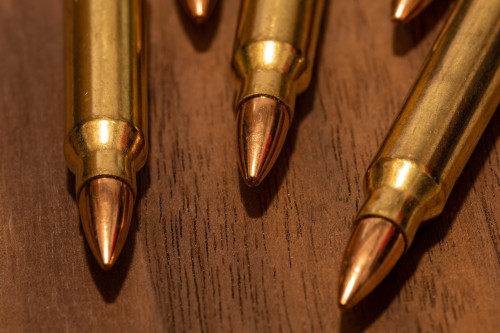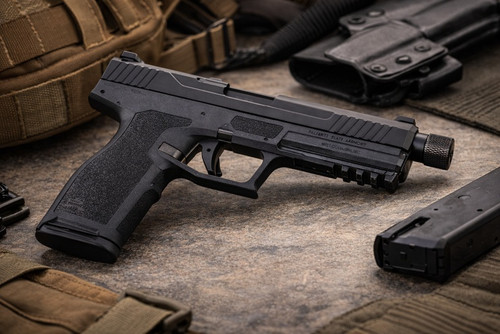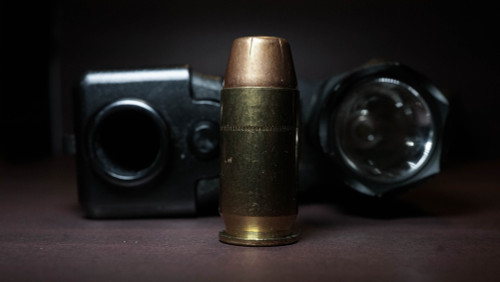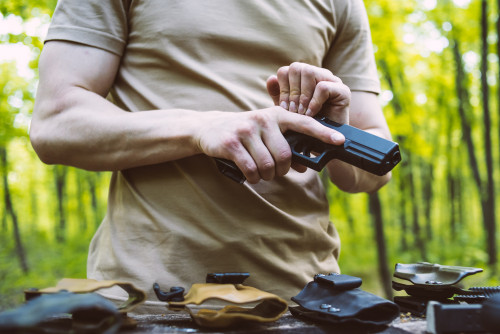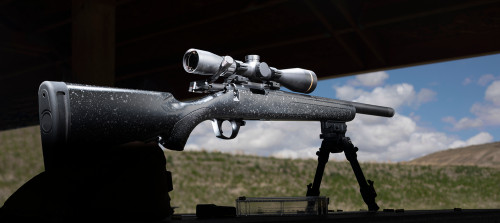No, not the movie with Private Pyle and Gunnery Sergeant Hartman — we’re talking about full metal jacket (FMJ) ammo. Yes, the movie is named after FMJ ammo, but in reality, it describes bullets that have a lead core and are mostly enveloped inside a jacket of copper. They typically include an exposed base, the reason for which we’ll cover later on.
But what’s it good for?
Full metal jacket is the world’s standard training and military ammo, but that’s not the whole story. Buckle up and we’ll take a deep dive into one of the most ubiquitous and least understood ammo types around: FMJ.
By Major tom at the English-language Wikipedia, CC BY-SA 3.0, https://commons.wikimedia.org/w/index.php?curid=2581236
What Is Full Metal Jacket Ammo?
Full metal jacket ammo is a cartridge with a bullet that has a lead core completely enclosed with copper. We say “a lead core” because lead is what the vast majority of ammo has inside of it (even though there are some lead-free variants).
Some ammo is solid copper to appease the tyrants in less-than-free states like California, which has banned lead entirely for use in projectiles. Although it sort of looks like FMJ, it’s far from the plinking- and budget-friendly lead-core options (because it’s uber expensive).
Typically, FMJ has a rounded or pointed nose or tip. Pistol bullets are rounded in many calibers like 9mm and .380 ACP, but others (like .40S&W) feature a flattened profile up front, called a truncated cone. Rifle FMJ almost always features a pointed tip, like 5.56, 7.62 NATO, and others. The civilian counterpart to the 5.56, the .223, is found in more sporting and hunting bullets such as soft point and hollow point. The same goes for the 7.62 NATO’s counterpoint, the .308 Winchester. The bulk of what the military buys is FMJ stuff, except for in specialty situations.
To better understand what makes FMJ different, let’s look at a couple of variations.
(Source: https://www.wideners.com/blog/what-is-a-jhp-bullet/)
Hollow Point
Hollow point ammunition is the other type you’ve heard of. The name is remarkably descriptive; the tip of the bullet contains a cavity, designed so that when the bullet encounters soft matter (a perp or a critter), fluid fills the cavity and forces the bullet to expand, oftentimes into the classic mushroom shape you see above. This creates a much more devastating wound than can be delivered by FMJ ammo.
Soft Point
SP ammo is basically an FMJ slug with the nose trimmed flat or left exposed, which delivers greater terminal effects upon impact. As the bullet hits soft tissue, the exposed lead at the front is smushed, which deforms the bullet, making it wider and shorter. The effect is a heinous wound cavity, making it particularly lethal in hunting scenarios.
Photo byJay Rembert onUnsplash
History of FMJ
FMJ has been the go-to ammo for bulk shooting and plinking only in the last 100 years or so. Prior to that, most bullets were just plain ol’ lead. Most weren’t even shaped like the pointy bullets we know today, but instead were just balls cast from molten lead. Their accuracy was often spotty.
Lead is great for bullets because it’s hard enough to withstand being fired from a gun yet soft enough to deform when it hits something. But as cartridges started getting faster (thanks to the wider adoption of smokeless powder), lead wasn’t up to the task. This is especially true today. Pretty much every new caliber and cartridge is designed with a jacketed bullet, whether it’s FMJ or some variant.
Corditem and black powder (which were popular before today’s smokeless powders) burn rapidly, whereas smokeless powder explodes under pressure, enabling guns to shoot faster than ever before with lightning-quick velocities. The need to protect the lead from getting too hot led to a thin layer of copper being swaged over the lead core. But melting lead contributed to barrel fouling, resulting in degraded accuracy. In the case of extra thick pluggage, a barrel could become too plugged to safely shoot — which is quite dangerous.
Okay, so it’s got a sweet metal jacket. But why?
Photo byThomas Ashlock onUnsplash
Advantages of FMJ Ammo
There are many advantages of full metal jacket ammo.
It’s Cheaper
First and foremost, FMJ is cheaper than alternatives such as hollow point, soft point, or any tipped variety of bullet. That’s because its simple construction makes it a comparative breeze to manufacture. The lead core has a thin sheet of copper (or gilding metal, which is 95% copper) swaged over it, which leaves the rear or bottom of the projectile exposed. After swaging, projectiles can be loaded into the brass case that’s primed and filled with gunpowder, creating a complete cartridge.
Want to save money on ammo? Subscribe to get quality rounds shipped to your door every month — from your friends here at Pro Armory. Get a lower price per box when you sign up.
It’s Stronger
This simple construction also makes FMJ ammo quite robust. Hollow point ammo relies on the cavity in the tip to do its job of expanding in soft tissue. As the void encounters the tissue, it fills with it, forcing the bullet to expand as it travels.
But particularly with rifle rounds, the cavity can be somewhat fragile and easily damaged after rattling around in a magazine for a while. This can worsen accuracy and expansion effectiveness. Because the vast majority of ammo the military uses is fed from a magazine or belt of some sort, the cartridges need to be pretty rugged.
It’s Simpler
Also, FMJ is as simple as it gets for bullet designs, and simpler is often better for mechanical devices. FMJ bullets are sleek at the tip, so they’re easy to feed from magazines into a gun’s chamber. In pistol rounds, hollow points are more prone to feeding malfunctions because of the gaping maw at the front. FMJ ammo lets your guns operate at their most reliable by virtue of their sleek design.
It’s Cleaner
Another advantage of FMJ ammo is that it’s cleaner than pure lead. Lead ammo is smoky and gunks up semi autos as the lead builds up in the barrel. This is especially true of rifles, which shoot cartridges with velocities faster than that of handguns.
That said, about the only lead rifle cartridges you’ll find these days are older “cowboy” calibers prevalent before swaging and jacketed bullets became popular.
Disadvantages of FMJ Ammo
But it’s not all roses and rainbows with FMJ. In fact, they’re outright banned for most hunting scenarios, and they don’t give you the best performance in self-defense scenarios or in the field.
For all its advantages, FMJ is kind of a turd in the performance department. Here, we’re talking about both accuracy performance and terminal performance (what happens when you shoot FMJ into soft tissue like a critter or bad guy).
Poor Accuracy
FMJ is often less accurate than other ammo variations because swaging isn’t always uniform around the whole bullet, making it thicker and heavier on one side. Think of the BBs you shot as a kid. Some of them had flat spots they got during manufacture, which led them to fly wildly off target.
This is expected because FMJ was designed to be used in high-volume scenarios — like providing covering fire or even saturating an area with fire. When you’re shooting “kinda over there, behind that fence row or shrub,” you don’t need match-grade accuracy. You need ammo that’ll reliably operate and get lead in the vicinity of the threat.
Poor Terminal Performance
When you do hit a target, FMJ isn’t the most reliable performer in terminal ballistics. Yes, some cartridges like the military M193 5.56x45mm NATO rifle round are designed to turn (yaw) and split in two when encountering soft tissue. However, it doesn’t always work that way in the wild. Sometimes a bullet “ice picks” straight through a target, leaving nothing more than a .223” hole behind. Other FMJ ammo is designed to tumble, which is cool, but only when it works.
Tumbling and yawing are very much velocity dependent. Tumbling and yawing mostly occur with longer barrels, around 20" or more. But the vast majority of AR shooters today use guns with shorter barrels, so the likelihood of seeing these desired effects is lessened with each lost inch. Most shooters are better off going with a soft point or tipped bullet of some kind.

Hornady Superformance 223 Rem. 53Gr V-Max 20/200
$24.15
Hornady
Prices accurate at time of writing
When it comes to handgun cartridges, you can forget about tumbling, yawing, and the like from FMJ. All you get is a hole (or two, if it goes all the way through the target). But you do get the benefits of maximum reliability and cheap price.
Legality and Ethics
Legality is a big issue for FMJ ammo. The only area you’ll run into issues is hunting. Because it doesn’t expand when it hits a critter, and is therefore less likely to kill the animal instantly (and therefore ethically), FMJ is outlawed for hunting in most states.
As a hunter, it’s your job to ensure you’re putting the critter down as quickly and humanely as possible. Why use ammo with suspect terminal performance when you can use something that almost guarantees violent expansion?
There’s one exception to this rule. Using huge, solid copper or FMJ ammo is preferable when hunting dangerous game, like African Cape Buffalo, elephant, rhino, and the like. These critters are so tough that you can forget about a bullet holding together after they impact; you need maximum penetration, so only a solid or FMJ in a ludicrously heavy caliber will do. When you’re targeting dangerous game or a deadly threat, you need it to drop right NOW.
On the other hand, FMJ is the standard for military usage. One result of the famous Hague Convention of 1899 was the outlawing of projectiles designed to expand or deform when they hit soft tissue. This is why the vast majority of the ammo our military uses is FMJ.
Can You Use FMJ for Self-Defense?
Is FMJ the best bet for two-legged assailants? In a pinch, yes. But the real question is, should you use FMJ for self-defense? The answer in most cases is no. Self-defense for our purposes chiefly pertains to pistol calibers and cartridges — both of which benefit from hollow point ammo in these scenarios.
Both the positives and negatives of FMJ ammo come into play in self-defense. Yes, you want ultimate reliability in a life-or-death situation, but you also want peak projectile effectiveness. That means expansion with reliability. FMJ provides only part of that equation (reliability).
That said, any ammo type is basically reliable if it works with your gun of choice (and isn’t so cheap it causes malfunctions). It’s a good idea to run at least 100 rounds of your preferred self-defense load through your gun to prove it runs flawlessly before carrying it.
Exceptions to the Rule
For most calibers, hollow points are the way to go for self-defense. But the main outliers are smaller calibers such as .25 ACP, .32 ACP, and even .380 ACP. The reason why you might consider FMJ for these calibers is twofold:
- First and foremost, most guns that are chambered in these calibers are small. As a rule, the smaller a pistol, the less reliably it runs. You want to give it every opportunity to run perfectly.
- The second reason why you might choose FMJ ammo in a smaller handgun caliber is because these calibers are weak and don’t deliver the velocity needed to make a hollow point open up. You’re basically getting FMJ performance out of HP bullets in a .25 ACP, so why not ensure maximum penetration and reliability and use FMJ?
Some smaller guns benefit from FMJ for function and effectiveness. (From top, a Kel-Tec P3AT and a Kahr CW380).
The Best Full Metal Jacket Ammo for Training
For the itsy bitsy .25 ACP, you want a nice, rounded ball shape for the best feeding. Fortunately, most have that functionality.
The .32 ACP approaches the generally agreed-upon minimum for self-defense, but you still want a nice, easy feeding round ball for training.

Sellier & Bellot 32Acp 73Gr Fmj 50/2000
$26.14
Sellier & Bellot
Prices accurate at time of writing
The Sellier & Bellot .32 ACP 73gr FMJ is a great option for training.

Hornady Critical Duty 32Acp 60Gr Ftx 25/250
$27.01
Hornady
Prices accurate at time of writing
If you need to have a fancy expanding bullet, Hornady Critical Duty .32 ACP 60gr FTX 25/250 is a good option.
The .380 is a good cartridge for small guns and small shooters, and carries enough wallop that it won’t get sneered at (most of the time).

Pmc Bronze 380 Acp 90 Grain Fmj + Ammo Can
$56.00
Pmc
Prices accurate at time of writing
There are plenty of options of .380 training ammo as well as more self-defense loads than our other mouse gun cartridges.

Pmc Bronze 380 Acp 90 Grain Fmj + Ammo Can + Handgun Fundamentals
$109.00
Pmc
Prices accurate at time of writing
Want to hit a home run? Try the all-in-one package of PMC Bronze 380 ACP 90gr for starters.

Federal Premium Personal Defense Hydra-Shok 380Acp 90Gr Jhp
$24.93
Federal
Prices accurate at time of writing
Are you recoil shy or shooting in a tiny gun? Try the reduced-recoil of the Federal Premium Personal Defense Hydra-Shok .380 load.
Final Thoughts
FMJ ammo absolutely has its place in every shooter’s range bag. It’s the most affordable kind of centerfire ammo, and it’s great for high-volume shooting, plinking, and ensuring your guns are as reliable as possible.
However, you won’t want FMJ in hunting or self-defense applications because of its spotty terminal performance. Spend a few more bucks and get a good quality hollow point bullet for concealed carry and defensive work.
Looking for training and/or self-defense ammo? Pro Armory has quality rounds at a price you can afford. Check out our selection of handgun, rifle, and shotgun ammo in various calibers and point-types, plus our curated selection of accessories to complete your loadout.
Want to learn more about firearms safety and tactical maneuvers? Pro Armory offers training to help you become a better shooter all around. Sign up for our newsletter to learn more about training, ammo subscriptions, and more.



